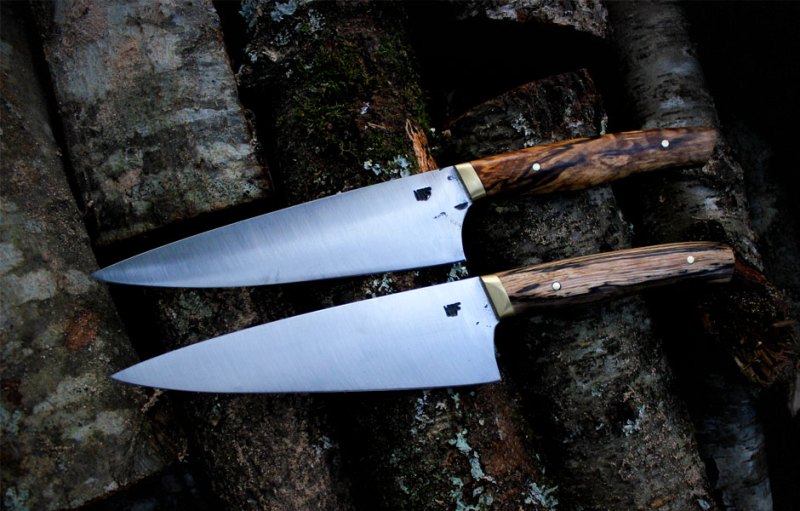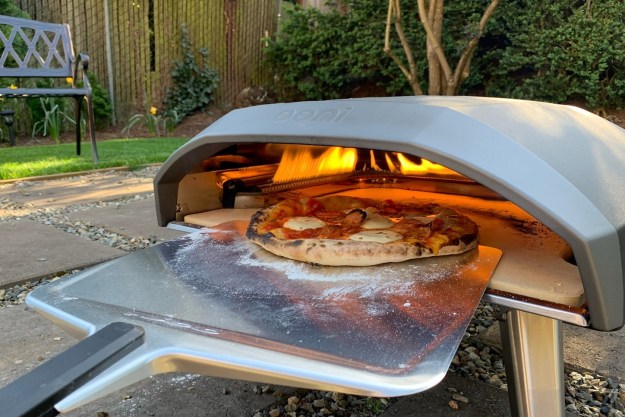
Feasting is a column dedicated to cooking, grilling, eating and discovering what’s on the menu across America and the world.
A really great meal starts with a few essentials. Quality ingredients and the correct balance of this and that of course matter most. But nothing will take your culinary skills to the next level like having and knowing how to use the proper knives. So when we came across Heartwood Forge, we had to learn more about how their beautiful knives are built. Handmade in Athens, Georgia by artisan Will Manning, he uses recycled materials to craft every single knife from start to finish. We chatted with him to learn more about his process, how he chooses the right materials and the biggest blade he’s ever forged.
Heartwood Forge is all about using the by-products of industry to craft handmade knives, and it started when you would straighten nails for your dad to reuse as a kid. Did this begin as a curiosity or was there a real awareness about the importance of recycling, even back then?
The nail straightening stemmed from my fathers combination of frugality, belief that young kids should be expected to work and the philosophical ideas behind reuse. So yes, awareness about the importance of recycling has been something I’ve grown up with.
You test all the old steel you find in-house then send it to a lab in St. Louis to find out its exact composition. Which types of steel work best for the different kinds of knives you make?
One of the best steels I use comes from antique saw blades. Some are composed of 1095 carbon steel and perform well for everything, as it’s a really basic alloy. I mostly use it to make chef’s knives, santokus and sujihikis, long strong builds for all-purpose use. I also have some high nickel alloy that is insanely tough and doesn’t perform well as a super thin chefs knife but makes a heck of a bone-breaking cleaver. A modern steel I’m stoked to have a steady supply of from a central GA lumber mill (it’s crazy but one nail from an old deer stand on a tree can break the usability of the blade for the mill’s purpose, so they pass them to me!) is a Swedish bandsaw proprietary steel that came back from the lab as “unknown.” But based on the chemical composition, properties and shop tests, it is a conglomerate of two well-known alloys, L6 and 15n20. It’s thin though, so there are constraints as to what it can make. It’s great for fillet and paring knives.
You also use recycled wood for the handles. What are your favorite kinds of wood to work with and why?
I get a wide variety of interesting woods, but I have to say I love working with walnut and cherry. They’re basic woods that are familiar to me. They were around a lot growing up, so I’m familiar with their feels, smells and finishes.
You make every knife by forging the metal. Could you explain this process a little further and why it’s the method you use?
Actually, not all knives are forged – the bandsaw material is super thin to start with and doesn’t need to be forged. But all other knives are forged, and I do this by applying heat to the steel in a forge and hammering the blade to shape with a hammer and anvil. Forging is my favorite part of making a knife. It’s very meditative and instinctual. It also makes better use of the available material. It’s a forgiving process because instead of removing material and never using it again, it’s rearranged to be used as part of the blade and the handle. People are always amazed when I show them the rectangular shape the knives start out as. For me, forging is a very creative process that relies very much on the feel. Hammering a knife is so very different than drawing a design on paper. It sort of takes on a life on its own.
You also do custom work. Do you ever get any outrageous or weird customer requests? Can you remember the knife that took you the longest time to craft?
I made a champagne saber for a really good friend’s wedding. It was 16 inches long! He’s a vampire apocalypse kinda guy, so the blade was inscribed with “til death do us part.” His nephew was totally psyched about the fact you get a giant knife when you get married.
When caring for your knives, what are some of the most important tips to remember?
Number one, keep it dry. Most of the other care instructions are available on the website.
To learn more about how Heartwood Forge Knives are made and to see the entire line, visit heartwoodforge.com.
Editors' Recommendations
- 10 of the Best Kitchen Knives to Gift This Year
- The 9 Best Fillet Knives to Include in Your Kitchen This 2022
- Knife Aid Sharpens Your Knives For You (and You Don’t Have to Leave Home)


